

|
|
-- examining geopolitical-demographic-economic characteristics and patterns January 2021 Census 2020 Updates
This section will update soon with new information, applications and user tools/resources
regarding the Virginia Census 2020 P.L. 94-171 redistricting data.
The Virginia P.L. 94-171 geography were released in the form of shapefiles on January 19, 2021.
See more these data here.
The Census 2020 P.L. 94-171 block level demographic data may be available in March 2021.
ProximityOne has integrated the Census 2020 P.L. 94-171 shapefiles into a GIS project for use with the ProximityOne CV XE GIS software. Participants in the Census 2020 Data Analytics program may use these tools and data on their own Windows based computers. Contact us for details. See illustrative views of Virginia State Legislative Districts with voting precincts below in this section. The remainder of this section has been developed using Census 2010 and 2019 data resources ... The following two maps show outcomes of the November 2019 Virginia State Legislative District elections. More voting outcomes data to follow. Virginia 2019 House Election Outcomes Democrat districts shown with blue fill pattern; Republican districts shown with red fill pattern. Of the 100 districts, 54 are Democrat and 43 are Republican. Click graphic for larger view that shows district number. Expand browser window to full screen for best quality view. 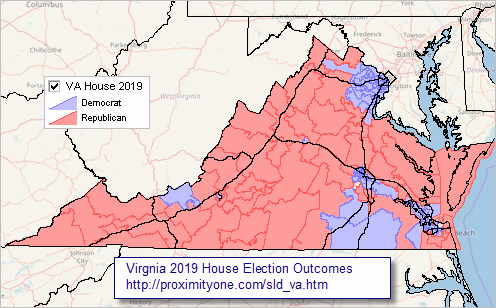 - View developed using ProximityOne CV XE GIS and related GIS project. - Use ProximityOne GIS tools and data to develop drill-down views; add your own data. Virginia 2019 Senate Election Outcomes Democrat districts shown with blue fill pattern; Republican districts shown with red fill pattern. Of the 40 districts, 21 are Democrat and 19 are Republican. Click graphic for larger view that shows district number. Expand browser window to full screen for best quality view. 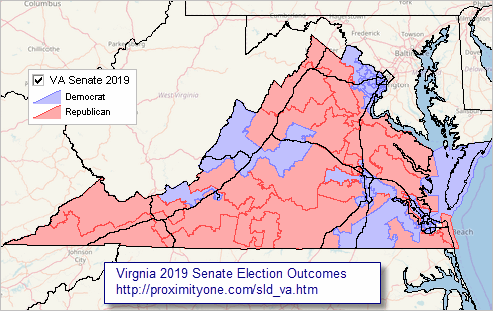 - View developed using ProximityOne CV XE GIS and related GIS project. - Use ProximityOne GIS tools and data to develop drill-down views; add your own data. The remainder of this section will be updated to reflect the 2019 elections and other data updates progressively. State Legislative Districts (SLDs) are areas from which members are elected to state or equivalent entity legislatures. The state legislative districts include the Upper/Senate (SLDU) and Lower/House (SLDL) chambers of the state legislature. While this section focuses on Virginia, all aspects are transportable and apply to any state or region. In this section: • Use the interactive table below to examine Virginia SLD characteristics .. create SLD Profiles using the table • Examine Virginia metropolitan areas; see table with links below .. view extended metro geographic-demographic-economic profiles • View illustrative SLD Reports for specific SLDs • SLDs are diverse. See more about SLDs below • Join the Congressional District-State Legislative District Group; see below. • Join us in an upcoming face-to-face CDSLD Data Analytics Session. • Use the CDSLD GIS Project .. about GIS. .. create CDSLD maps; add other data; geospatial analysis • Integrated Use of these Data Analytics Resources • See related sections. Patterns of Economic Prosperity - Virginia Upper/Senate SLDs by Median Household Income 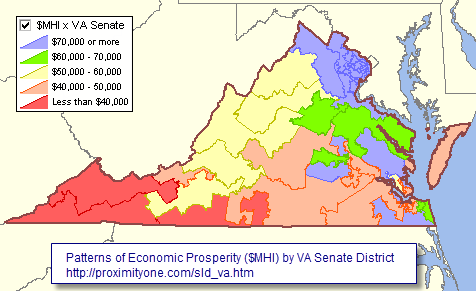 - click graphic for better quality view; districts labeled with district code - developed using the CV XE GIS software and related GIS project Patterns of Economic Prosperity - Virginia Lower/House SLDs by Median Household Income 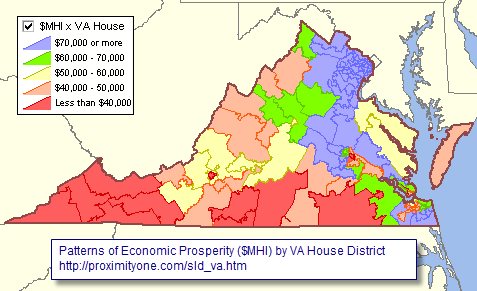 - click graphic for better quality view; districts labeled with district code - developed using the CV XE GIS software and related GIS project Virginia Metros & Counties .. goto top - Virginia Metropolitan Statistical Areas (MSAs) 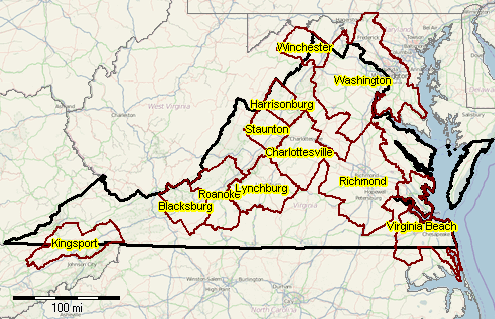 - click graphic for larger, better quality view; showing counties with names - developed using the CV XE GIS software and related GIS project Virginia Metropolitan Statistical Areas (MSAs); Access S&O Reports .. goto top - MSAs partly/entirely in Virginia; click code link to view S&O report; see all metros trends interactive table
New York Metro House Districts & Economic Prosperity by ZIP Code Illustrative GIS application showing legislative districts contextually with other geography & subject matter. House districts black boundary & district code; patterns of median household income by ZIP code. 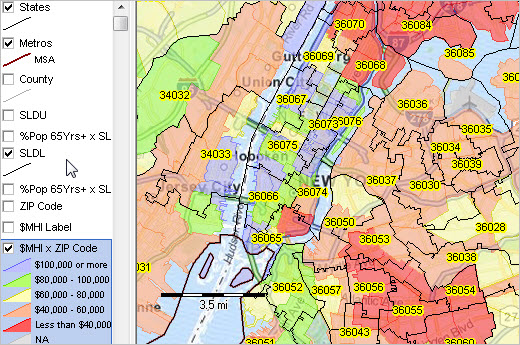 - View developed using CV XE GIS and related GIS project. - see below in this section about using this GIS project. All U.S. State Legislative Districts (SLD) sections: • SLD Demographic-Economic Interactive Tables Congressional District-State Legislative District Group .. goto top The Congressional District-State Legislative District (CDSLD) Group is a forum intended for individuals interested in accessing and using geodemographic data and analytical tools relating to voting districts, congressional districts & state legislative districts. Join the CDSLD Group to receive updates on these topics, data analytics and access to GIS-related resources. .. there is no cost. Virginia State Legislative Districts -- Demographic-Economic Characteristics -- interactive table This table has not been updated to reflect 2019 elections; please check back. The interactive table shown below includes one row for each VA state legislative district. Click column header to sort; click again to sort other direction. Click link in District column to view maps and drill down data to block group level. .. presently active for H011,H044,H045,H053,S036. See related interactive tables Table Notes and Usage Statistical Data from American Community Survey 2016 5-year estimates (ACS1216). Operations: • Click ShowAll button between queries. • View list of all House/Lower districts (Chamber H): - click ShowAll button. - optionally select a state (left dropdown below table). - click District Type selector below table and choose H; table refreshes. • Select one district by district ID/code. - click ShowAll button. - key in exact spelling of District code; follow template shown for default H044 - the code must be 4 characters, start with H or S followed with 3 digit code with lead zeroes - click FindDist button; table refreshes with rows where text entered matches District column. • Select one district by incumbent name. - click ShowAll button. - key in exact up/low spelling of any part of incumbent name - click FindName button; table refreshes with rows where text entered matches FullName column. • Select Column Sets. - click ShowAll button. - click a column sets button below table; table refreshes showing only selected columns. • Select a combination of Chamber & Party. - click ShowAll button. - key in H or S in Chamber & Party left edit box. - key in D or R in Chamber & Party right edit box. - click Chamber & Party button - tables refreshes with SLDs meeting those criteria. • Export a set of district rows. - click ShowAll button. - click checkbox on each district to be selected (row turns blue). - right click blue area to copy to clipboard; paste in spreadsheet then transpose.. Example of Using Column Set Buttons - click ShowAll button. - click Chamber & Party button, selecting on H-D rows .. table refreshes. - click Econ Cols button .. table refreshes. - click on Median Household Income column header cell, sorting in descending order. - view now appears as shown below.  - among House districts with Democrat incumbents, H034 has the highest $MHI; .. click $MHI header cell again to see that H071 has the lowest $MHI for this set of districts. - scroll down the rows to find the rank (left column) of a district of interest. - to view a specific district by code, use the FindDist button (See above). - to view a specific district by incumbent name, use the FindName button (see above). Notes on Using Data in Table As noted elsewhere, data in the table are sourced from the American Community Survey 2016 5 year estimates (ACS1216). These data are based on a sample of respondents to a 5-year survey spanning calendars years 2012 through 2016. The estimates are centric to 2014. These are the most recent data available as of December 2017 and will update with ACS 1317 estimates in December 2018. These data are estimates and subject to errors of estimation and other sources of error. That said, we have used these data over a very long period for wide-ranging geographic levels and find the estimates to be very good and accurate depictions of actual circumstances. Note that for areas 65,000 population and over, ACS 2016 1-year estimates (ACS2016) are available. The 1-year estimates provide a more current estimate and generally more accurate. The 1-year estimates are not available for SLDs but are available for states, larger metros and counties and all 115th CDs. For example, the ACS 2016 1-year total population estimate for Virginia is 8,411,808 (centric to 2016) whereas the ACS 2016 5-year total population estimate is 8,310,301 (centric to 2014 and vintage to use when comparing state to SLDs). Use these API calls via browser to access the above data. 2016 1-year state of Virginia, total population: https://api.census.gov/data/2016/acs/acs1/profile?get=DP05_0001E&for=state:51 2016 5-year state of Virginia, total population: https://api.census.gov/data/2016/acs/acs5/profile?get=DP05_0001E&for=state:51 And, median household income ... 2016 1-year state of Virginia, $MHI: https://api.census.gov/data/2016/acs/acs1/profile?get=DP05_0001E&for=state:51 2016 5-year state of Virginia, $MHI: https://api.census.gov/data/2016/acs/acs5/profile?get=DP05_0001E&for=state:51 The ACS 2016 1-year $MHI estimate for Virginia is $68,114 (centric to 2016) whereas the ACS 2016 5-year $MHI estimate is $66,149 (centric to 2014 and vintage to use when comparing state to SLDs). Items in Table .. see illustrative profile below CD/SLD Visualizing Demographic Patterns Reports .. goto top .. prepared for individual CDs/SLDs. .. SLD visual analyses; collaborating with these resources; examples: - Virginia House District 11 (Roanoke) - Virginia House District 13 (Prince William County-Manassas area) - Virginia House District 44 (Fairfax County) - Virginia House District 45 (Alexandria-Fairfax-Arlington Counties) - Virginia House District 53 (Fairfax-Falls Church Counties) - Virginia Senate District 35 (Fairfax County; Falls Church) - Virginia Senate District 36 (Fairfax-Prince William - Stafford Counties) .. Congressional Districts - Virginia CD 01 Create State Legislative Districts Profiles .. goto top .. prepare for individual/comparison SLDs using the table above. Example for VA House Districts 11 & 44: .. access this profile as an XLS file developed from table above. Comparing Two Districts
2016 State Legislative Districts .. goto top All 50 states, and D.C. and Puerto Rico, participated in Phase 4 of the Census Bureau Redistricting Program, as part of P.L. 94-171. All states and areas provided the Census Bureau with the 2016 election cycle boundaries, codes, and in some cases names for their state legislative districts. States provided updates for their boundaries used in the November 2016 elections for the session that began in January 2016. The Census Bureau develops standardized SLDU and SLDL shapefiles. The following states had changes to their state legislative districts for 2016: Florida (upper house only), Minnesota, Maryland (lower house only), Georgia (lower house only). As of 2016, the 6,558 state legislative districts in the U.S. are comprised of 4,629 lower/house chambers and 1,929 upper/senate chambers. Of the total state legislative districts, 1,257 are 100-percent urban (every census block comprising the district is urban), 19 are 100-percent rural, and 927 are less than 1-percent urban. Use the interactive table in this section to view, rank, compare state legislative districts by rural and urban population and geographic area. SLD Mapping and GeoSpatial Analysis Use GIS tools to visually examine U.S. or state by state legislative district patterns such as percent population urban. 2016 State Legislative District (SLD) boundaries used here are based on the TIGER/Line shapefiles. 2016 SLDs - Upper click graphic for view 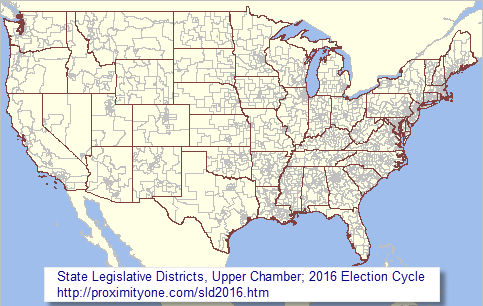 2016 SLDs - Lower click graphic for view 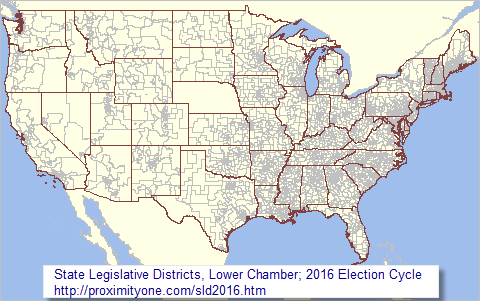 Integrated Use of these Data Analytics Resources .. goto top Use of these SLD data analytics resources is centered on 1) knowing more what, where, when and how of demographic-economic attributes for one SLD, SLD geodrill-down and a set of SLDs and 2) conceptualized around strategies. These can be best understood through face-to-face sessions focused/presented in these contexts: - a lead that speaks to the broader geographic-demographic-economic framework - VA; VA in context of region & US - the metro in which presented -- an oral and connecting the parts review of this: - example: Richmond metro Situation & Outlook The following frames a dynamic presentation using the CDSLD VA GIS Project. 1) know your district (drill down to intersection), about other districts, how your district relates - a presentation about this sort of capability: what it is saying and how it can be used: - like http://proximityone.com/cdsld/vaslds035.htm (one for each participant) - why and how to use this: http://proximatyone.com/sld_va.htm#table ... and how to extend it 2) how Democratic Promise (DP) and other initiatives can blend/benefit with/from use of the tools, data and methods - as it relates to DP, this would involve adding DP addresses (with related actions) to the CDSLD_VA GIS project - where there activity, what seems to be working, where planned activity is located. - more broadly examples; showing where medicare recipients are at BG level rather than SLD level 3) how these data, tools, methods facilitates D wins in 2018 & 2019 - Analysis and data are summarized at the block and block group levels - models, with continuously updating data, are used to predict outcome for every VA election (at least SLD/CD/state - policy/action eg GOTV tools are integrated to show what impact what action/resource allocation has on each election Related Sections .. goto top Congressional Districts - CD Map Gallery - 2016 115th Congressional Districts interactive tables: .. General Demographics .. Social Characteristics .. Economic Characteristics .. Housing Characteristics - urban/rural: .. Urban-Rural Analysis - incumbents & analysis: .. Incumbents & GIS - relationship data: .. ZIP Code to CD 114 Voting Related - CVAP x Tract - CVAP x 114th CD - Voting Districts - Voting Population - Voter Participation Illustrative Views: Using Census 2020 P.L. 94-171 Geography .. goto top The graphic below illustrates how upper and lower state legislative districts be viewed/analyzed using GIS tools with the Census 2020 P.L. 94-171 shapefiles, anywhere in the U.S. This view shows a zoom-in to the intersection area of these districts. • VA SLDU 36 -- gray boundary with forward hatch pattern. • VA SLDL 44 -- blue dotted boundary with backward hatch pattern. Click graphic for larger view. Larger view shows similar depiction with labeled voting districts/precincts added. Expand browser window for best quality view. . 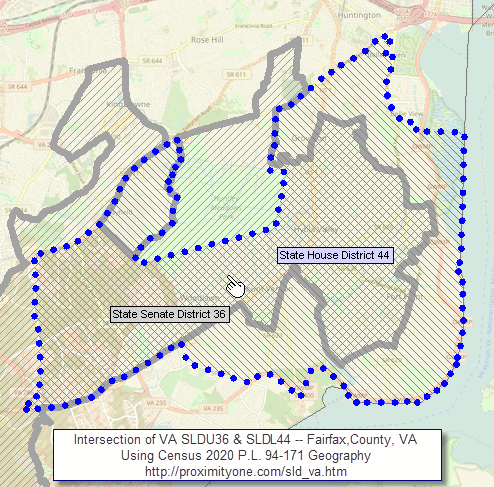 - view developed using ProximityOne CV XE GIS and related GIS project. - see related Census 2020 P.L. 94-171 Virginia Census 2020 Census Blocks in Context of State House District 44 & Region  - view developed using ProximityOne CV XE GIS and related GIS project. - see related Census 2020 P.L. 94-171 - click graphic for larger view. Expand browser window for best quality view. Virginia Census 2020 Census Blocks in Context of State Senate District 36 & Region 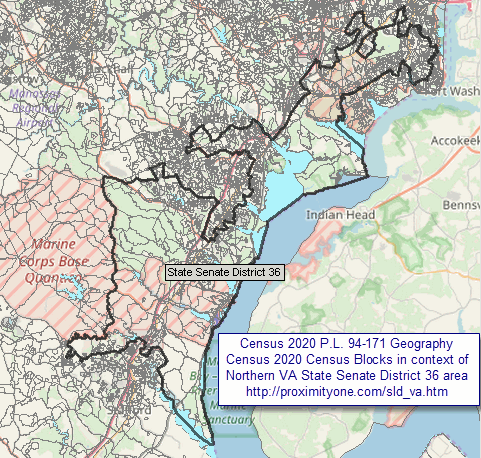 - view developed using ProximityOne CV XE GIS and related GIS project. - see related Census 2020 P.L. 94-171 - click graphic for larger view. Expand browser window for best quality view. Support Using these Resources .. goto top Learn more about demographic economic data and related analytical tools. Join us in a Data Analytics Lab session. Each informal session is focused on a specific topic. The open structure also provides for Q&A and discussion of application issues of interest to participants. ProximityOne User Group Join the ProximityOne User Group to keep up-to-date with new developments relating to geographic-demographic-economic decision-making information resources. Receive updates and access to tools and resources available only to members. Use this form to join the User Group. Additional Information ProximityOne develops geodemographic-economic data and analytical tools and helps organizations knit together and use diverse data in a decision-making and analytical framework. We develop custom demographic/economic estimates and projections, develop geographic and geocoded address files, and assist with impact and geospatial analyses. Wide-ranging organizations use our tools (software, data, methodologies) to analyze their own data integrated with other data. Follow ProximityOne on Twitter at www.twitter.com/proximityone. Contact us (888-364-7656) with questions about data covered in this section or to discuss custom estimates, projections or analyses for your areas of interest. | ||||||||||||||||||||||||||||||||||||||||||||||||||||||||||||||||||||||||||||||||||||||||||||||||||||||||||||||||||||||||||||||||||||||||||||||||||||||||||||||||||||||||||||||||||||||||||||||||||||||||||||||||||||||
|
|